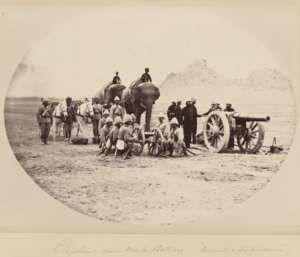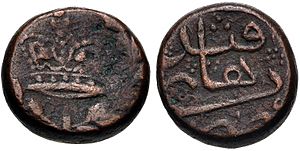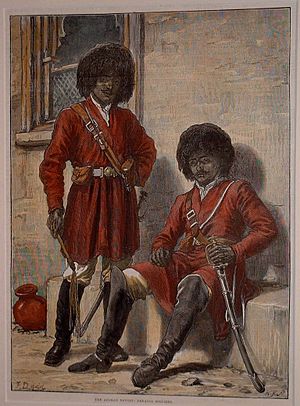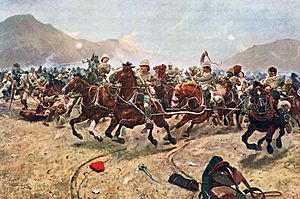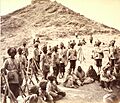Second Anglo-Afghan War facts for kids
Quick facts for kids Second Anglo–Afghan War |
|||||||||
|---|---|---|---|---|---|---|---|---|---|
| Part of the Great Game | |||||||||
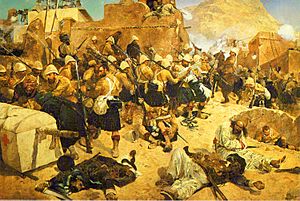 92nd Highlanders at Kandahar. Oil by Richard Caton Woodville Jr. |
|||||||||
|
|||||||||
| Belligerents | |||||||||
|
|
|||||||||
| Commanders and leaders | |||||||||
|
|||||||||
| Casualties and losses | |||||||||
|
Total fatalities are unknown
|
Total: 9,850 fatalities
|
||||||||
The Second Anglo–Afghan War was a fight between the British Raj (which ruled India) and the Emirate of Afghanistan. It happened from 1878 to 1880. At that time, Afghanistan was led by Sher Ali Khan.
This war was part of a bigger struggle called the Great Game. This was a rivalry between the British Empire and the Russian Empire over control in Central Asia.
The war had two main parts. The first part began in November 1878 when the British invaded Afghanistan. They won quickly, forcing the Afghan ruler, Sher Ali Khan, to run away. His son, Mohammad Yaqub Khan, then signed a peace deal called the Treaty of Gandamak in May 1879.
However, the peace did not last long. A British group in Kabul was attacked and killed in September 1879. This started the second part of the war. The fighting ended in September 1880 when the British defeated Ayub Khan near Kandahar. A new ruler, Abdur Rahman Khan, was chosen by the British. He agreed to the peace treaty again.
After the war, the British left Afghanistan. They had achieved their goals, creating a safe area between their Indian Empire and the Russian Empire.
Contents
Why the War Started
After some tension between Russia and Britain in Europe, Russia started looking at Central Asia. In the summer of 1878, Russia sent a group of diplomats to Kabul, Afghanistan's capital.
Sher Ali Khan, the ruler of Afghanistan, tried to keep them out but failed. The Russian diplomats arrived in July 1878. A month later, Britain demanded that Sher Ali also accept a British diplomatic group.
The Afghan ruler refused to let the British group enter. He even threatened to stop them if they tried. So, Lord Lytton, who was in charge of British India, ordered a British group to go to Kabul in September 1878.
But this group was turned back at the Khyber Pass. This event officially started the Second Anglo–Afghan War.
The War Itself
First Part of the War
The first part of the war began in November 1878. About 50,000 British and Indian soldiers entered Afghanistan. They attacked from three different directions.
The British won important battles at Ali Masjid and Peiwar Kotal. These victories left the way to Kabul almost open for the British.
Sher Ali Khan was very worried. He tried to get help from the Russian Tsar, but the Russians told him to make peace with the British. Sher Ali went back to Mazar-i-Sharif and died there in February 1879.
The Peace Treaty
With British forces controlling much of Afghanistan, Sher Ali's son, Mohammad Yaqub Khan, became the new ruler. To stop the British from taking over more of the country, he signed the Treaty of Gandamak in May 1879.
Under this treaty, Yaqub Khan gave Britain control over Afghanistan's foreign affairs. He also received money each year and promises of help if other countries attacked. British representatives were placed in Kabul and other cities.
Britain also gained control of important mountain passes like the Khyber Pass. Some areas, like Quetta, were given to Britain. After the treaty, the British Army left Afghanistan.
However, on September 3, 1879, a rebellion happened in Kabul. Sir Louis Cavagnari, the British representative, and his staff were killed. This terrible event started the next part of the war.
Second Part of the War
Major General Sir Frederick Roberts led British forces into central Afghanistan. They defeated the Afghan Army at Charasiab in October 1879. Two days later, they took control of Kabul.
Later, a large force of 10,000 Afghans attacked the British near Kabul in December 1879. This attack failed, and the rebellion ended. Yaqub Khan was suspected of being involved in the attack on the British group, so he had to give up his rule.
The British thought about different ways to govern Afghanistan. They decided to make Yaqub's cousin, Abdur Rahman Khan, the new ruler.
Meanwhile, Ayub Khan, another Afghan leader, started a revolt. He defeated a British group at the Battle of Maiwand in July 1880. He then surrounded the city of Kandahar.
General Roberts quickly led the main British force from Kabul. On September 1, he decisively defeated Ayub Khan at the Battle of Kandahar. This battle ended Ayub Khan's rebellion.
What Happened After the War
With Ayub Khan defeated, the war was officially over. The British chose and supported Abdur Rahman Khan as the new ruler of Afghanistan. Rahman agreed to the Treaty of Gandamak again.
This meant Britain controlled the lands given up by Yaqub Khan. Britain also controlled Afghanistan's foreign policy. In return, Afghanistan received protection and money. The Afghan tribes kept their own internal rules and customs. Afghanistan also continued to be a buffer zone between British India and the Russian Empire.
The British decided not to keep a British representative in Kabul anymore. They had achieved their main goals. By April 1881, all British and Indian soldiers had left Afghanistan. However, British agents stayed behind to help with communication between the governments.
There were no more major problems between Afghanistan and British India during Rahman's rule. He became known as the 'iron Amir' because of his strong leadership. The Russians also mostly stayed out of Afghanistan's internal affairs.
In 1893, Mortimer Durand came to Kabul from British India. He signed an agreement with Rahman to set the borders of their areas of influence. This agreement, called the Durand Line Agreement, was reached on November 12, 1893. It led to the creation of a new North-West Frontier Province.
Important Battles
Here are some of the key battles and actions from the Second Anglo–Afghan War (1878-1880). An asterisk (*) means a special medal clasp was given for that battle.
1878 Battles
- Battle of Ali Masjid* (British won)
- Battle of Peiwar Kotal* (British won)
1879 Battles
- Action at Takht-i-Pul (British won)
- Action at Matun (British won)
- Battle of Khushk-i-Nakud (British won)
- Battle of Fatehabad (Afghan won)
- Siege of the British Residency in Kabul (Afghan won)
- Battle of Kam Dakka (Afghan won)
- Battle of Charasiab* (British won)
- Battle of Shajui
- Battle of Karez Mir
- Battle of Takht-i-Shah
- Battle of Asmai Heights* (Afghan won)
- Siege of Sherpur (Kabul)* (British won)
1880 Battles
- Battle of Ahmed Khel* (British won)
- Battle of Arzu
- Second Battle of Charasiab (British won)
- Battle of Maiwand (Afghan won)
- Battle of Deh Koja (Afghan won)
- Battle of Kandahar* (British won)
1881 Events
- British-led forces left Kandahar and Afghanistan.
Images for kids
-
Drummer James Roddick of the Gordon Highlanders defends a wounded officer during British attack at Gundi Mulla Sahibdad during the Battle of Kandahar.
-
45th Rattray's Sikhs guard Afghan prisoners during an advance through the Khyber Pass.
See also
- First Anglo-Afghan War
- Third Anglo-Afghan War
- European influence in Afghanistan
- Military history of Afghanistan
- Sherpur Cantonment


